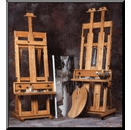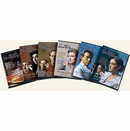Pencils
The pencil is the most basic of art tools, yet the one you choose for your next art project can be crucial to how your piece will look when it's finished. Once you select the pencil you want to use, even the way you hold the pencil will determine the overall effect. The thickness, color and texture of the lead will combine to produce a certain look, and only you can determine which pencil is right for your current piece.
Don't select a pencil on price alone. That cliche, "You get what you pay for" may be old, but it still holds true. Make sure the pencil will be bold enough and that the lead itself is just the right thickness for the look you are going for. You don't want something so thin that you can barely see it. Instead, choose a mid-grade pencil which should be bold enough to be noticed, although subtle enough so as not to overtake the entire look you are aiming for.
This is my own experience with drawing - its importance to how a piece will end up.
Choose your art pencil wisely because it will affect the look of the work you are trying to achieve.
The basic principles of pencil making have remained the same over the centuries, although production methods have obviously changed considerably. Essentially, a colour or graphite strip is sandwiched between two pieces of wood then cut and finished into the shape required. This is now almost a fully automatic process whereas at one time every single stage was carried out by hand. Let’s take a look back at how pencils were made in the Derwent factory long ago:
WOODWORK
Creating the woodcase
Entire logs of incense cedar were shipped to the factory from South America and laboriously sawn up into different lengths. These were then cut into thin planks and a channel grooved out to accept the graphite pieces. A further plank was cut to eventually fit on top. The continual hum of the saw and clouds of wood dust created must have made this a very unpleasant working environment.
CORE
Mixing the core
Only graphite pencils were made in the early days and the strip or lead consisted of pure Cumberland graphite. This was simply cut to roughly the required shape and inserted into the pencil groove. However, stocks of Cumberland graphite dwindled in the early 1800s and imported graphite was used instead. This was often clogged with grit and sand particles which had to be removed by crushing the graphite, then sifting and cleaning it. The graphite particles were then heated and compressed into oblong slabs.
ASSEMBLING
Assembling the pencils
The next stage was to glue the graphite pieces into the pencil grooves. Sometimes the pieces had to be rubbed down to fit and up to four might be needed to create a single pencil. Any surplus graphite was simply scraped away. (This was a messy process and the workers looked like chimney sweeps by the end of the day!)
A further piece of wood was then glued on top and several of these pencil ‘blocks’ were clamped together and left to dry. Each was then passed through a machine with a revolving cutter to create the familiar round pencil barrel.
FINISHING
Finishing
The completed pencils were then smoothed with a plane and polished by manually rubbing them up and down in a leather covered roller and board. Varnishing the pencils was a later development designed to enhance the natural colour of the wood. It also helped prevent the pencils getting dirty during the latter stages. Finally, the pencils were cut into uniform lengths with a saw and trimmed as necessary with a razor blade.
The pencils were then stamped with the company name and pencil type, either by a simple impression or by hand gilding in gold or silver leaf.
BOXING
Packing
Today, Derwent pencils are presented in a variety of attractive packaging to appeal to artists worldwide. However, in those early days the pencils were simply tied up in dozens and then in half grosses (i.e. 72s), ready for sale.
Although highly labour-intensive, the original factory could turn out 5 – 6 million pencils a year (although today it is not unusual for DERWENT to produce 1 million in a week!)
THE MANUFACTURING PROCESS TODAY
Derwent combines traditional pencil making skills, perfected by generations of local craftsmen, with state of the art manufacturing techniques. We pioneered many of the processes now in common use and our reputation for quality and consistency is unsurpassed in the art materials world. Let’s take a closer look at how Derwent pencils are made today:
CORE
Mixing the core
The strip or core of a colour pencil is made by mixing various pigments with clays, waxes and resins. Only the finest pigments are used to ensure maximum lightfastness, smoothness and purity. Graphite pencil strips are made by mixing graphite particles with clay and other binding materials in varying proportions to create different degrees of hardness (H) or blackness (B). The mixture is then extruded to form a strip, cut to the required length and, in the case of graphite pencils, fired in a kiln to remove excess moisture.
WOODWORK
Creating the woodcase
All our Derwent wood-cased pencils are made from the finest incense cedar wood, supplied in specially treated slats. The slats are grooved to accept the graphite or colour strips and, after bonding the strip into the groove, a further slat is placed on top. The resulting pencil ‘sandwich’ is cut into separate units which are made round or hexagonal, depending on the pencil being produced.
FINISHING
Finishing the pencils
All Derwent pencils feature a distinctive livery designed to reflect their quality and style. The pencil barrel itself may be natural or coloured, with a contrasting dipped end to aid identification. The pencils are finished using a unique UV process developed by Derwent as a more environmentally friendly alternative to lacquering. After shaping the pencils and rounding the edges, the pencils are imprinted with manufacturing information then automatically sharpened to a fine point.
DIPPING
Dipping for distinction
Dipping not only gives Derwent pencils a distinctive look but helps to identify the pencil range and exact colour. They are dipped twice at an angle, but dipped at a different length to create a stripe between the barrel and pencil end. The stripe identifies the pencil range while the end dip identifies the colour. This final dip is done using paints mixed on site to ensure an identical colour match.
BOXING
Packed to perfection
The completed pencils are stored in batches according to type or colour, then packed on demand. It can take up to 17 people to pack a tin of 72 pencils while a 12 tin takes eight – packing two tins at a time! Once the tins are full, the contents are shrink-wrapped for protection before the lids are put on. The finished product is then shrink-wrapped again to keep it looking pristine. Despite the manual effort involved, our packers can pack up to 1200 tins of 12 pencils per hour or up to 600 tins of 72.
(That is interesting!)









































